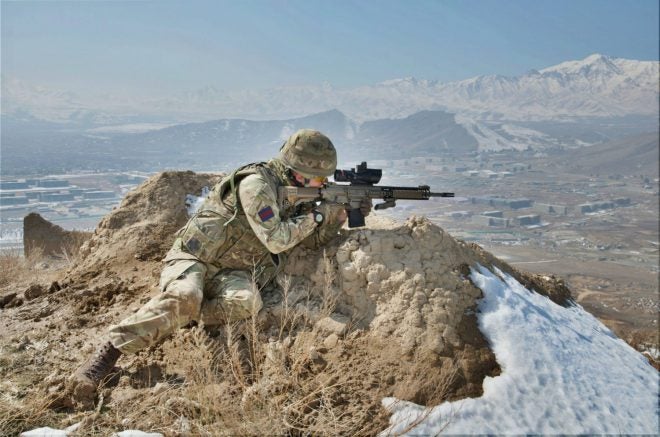Recent experience in Afghanistan, coupled with concerns about the effectiveness of the M4 Carbine – and perhaps also just a general long-term swing of the pendulum – has spurred many to advocate for a new configuration of infantry weapon centered around long range fire enabled by compact, efficient ammunition firing low-drag projectiles. I am not one of these advocates, and indeed it’s no secret that I find serious flaws with this approach to infantry small arms weapons systems. Still, this idea of having a long-range sharpshooter-centric force does seem to be gaining ground, and therefore I think it would be worthwhile to take some time to go down that rabbit hole and see where it leads. Our eventual goal in this endeavor is to paint a picture of a future infantry force that lives and works with these weapons, and what compromises they have to make to reap the benefits of such powerful long-range weapons.
Yesterday, we answered the question: “Assuming we had a new efficient long-range universal intermediate cartridge, what sort of weapon would we adopt to fire it?” Today, we’ll be going further in depth, talking about the costs of this new weapon system, both in terms of procurement and maintaining the edge in marksmanship.
First, let’s get into everyone’s favorite subject: Accounting. In the previous article, we outlined a weapon that would not only fire the new ammunition, but make the most of it (that is, after all, the point of adopting such a round). The weapon system broke down like so:
- Base rifle
- Long Range Rifle Optic
- Surefire M951
- PEQ-15
- Vertical fore grip
- Harris 9-13 bipod, LaRue Picatinny mount
- 25 round magazine loaded with long-range intermediate caliber ammunition
This setup is similar to how the British L129A1 Sharpshooter Rifle and USMC M27 Infantry Automatic Rifle are configured, and that’s not a coincidence. These weapons would all – despite their different calibers – have similar roles and therefore also similar requirements for precision, optical quality, and sustainment of fire. This also means that when determining how expensive the new long range infantry rifle might be, we can look to these two weapons as models.
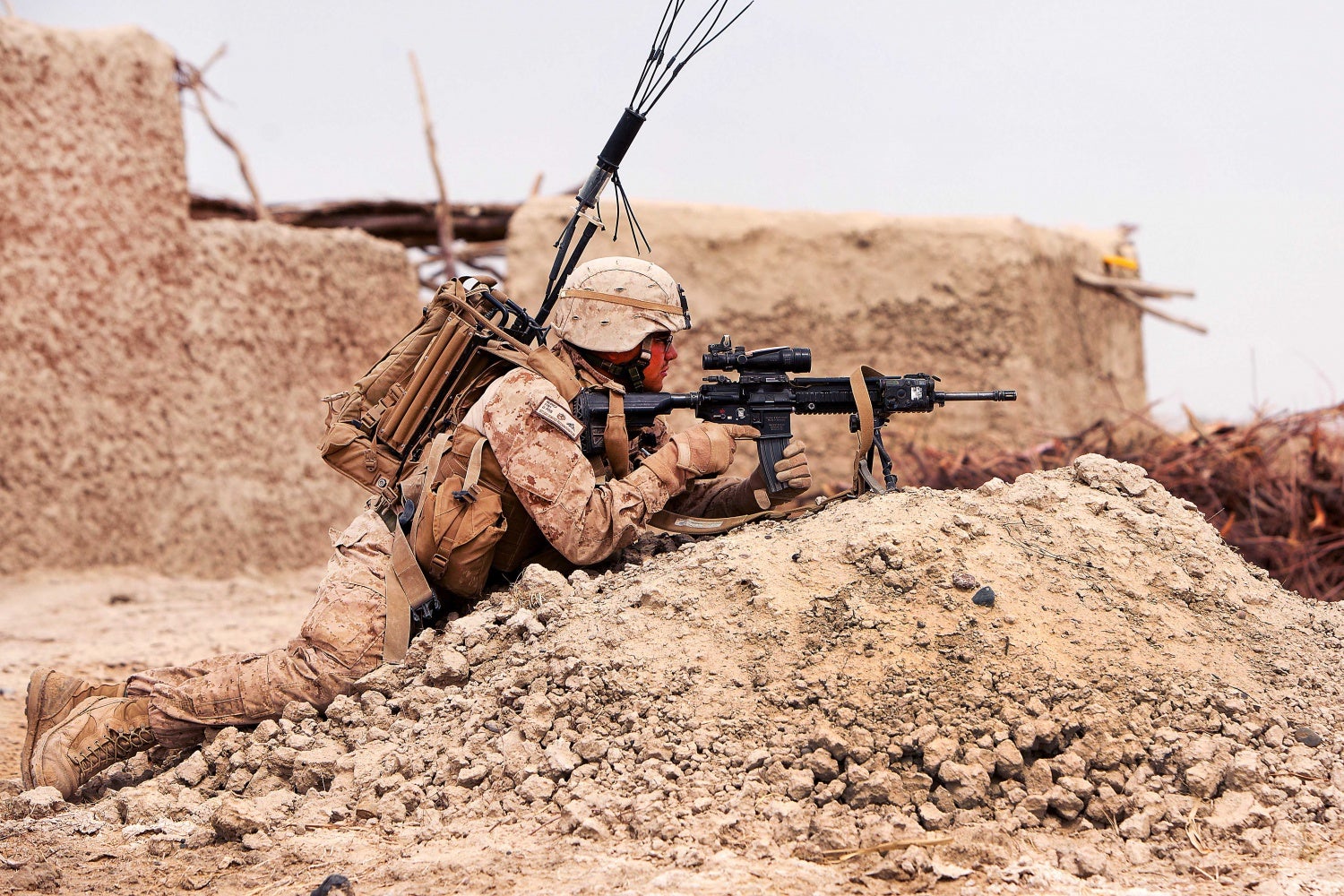
A Lance Corporal in the United States Marine Corps uses his M27 IAR to provide security for a patrol in the village in southern Afghanistan in March of 2012. Image source: commons.wikimedia.org
To start, let’s determine what the US Government paid for each M27 IAR, fully kitted out. While the contract was for $23.6 million for just over 4,000 rifles (resulting in about $6,000 per gun), this includes life cycle costs and spares. Reportedly, the actual unit cost of a single M27 IAR was roughly $3,000 per gun, and this apparently includes the bipod, foregrip, sling, and other accessories, but not the Trijicon Squad Day Optic. The SDO was purchased as part of a $33 million contract for 10,500 scopes, breaking down to $3,143 per scope, although again this probably included support and other costs not directly related to the to the optic. Civilian cost on an SDO is about $2,300, so we can assume the government price is somewhat lower. The M27 is also sometimes mounted with a laser unit like the PEQ-15 Advanced Target Pointer/Illuminating Aiming Laser, which is important for our purposes here. It’s not clear exactly what the US Army pays per unit for their PEQ-15s, but we do have an FBO listing of the United States Coast Guard ordering 500 PEQ-15Cs (the civilian version with less powerful laser) for $540 a unit. So then, a cost of $600 per for the military model seems reasonable, if just an educated guess.
The British L129A1 from Lewis Machine & Tool is a bit pricier, with 440 purchased as part of an ‘Urgent Operational Requirement’ in 2010 for about £1.5 million, or $2.5 million. That comes to a cost per unit of about $5,700 per gun, which includes a case, magazines, and other accouterments but (almost certainly) not the TA648-308 ACOG optic or the AN/PVS-27 Magnum Universal Night sight. We’re not worried about the cost of the MUN, and for our purposes the civilian cost of the TA648-308 (about $2,500) is close enough, especially since they were shipped with Trijicon RMRs for the sharpshooter rifle contract.
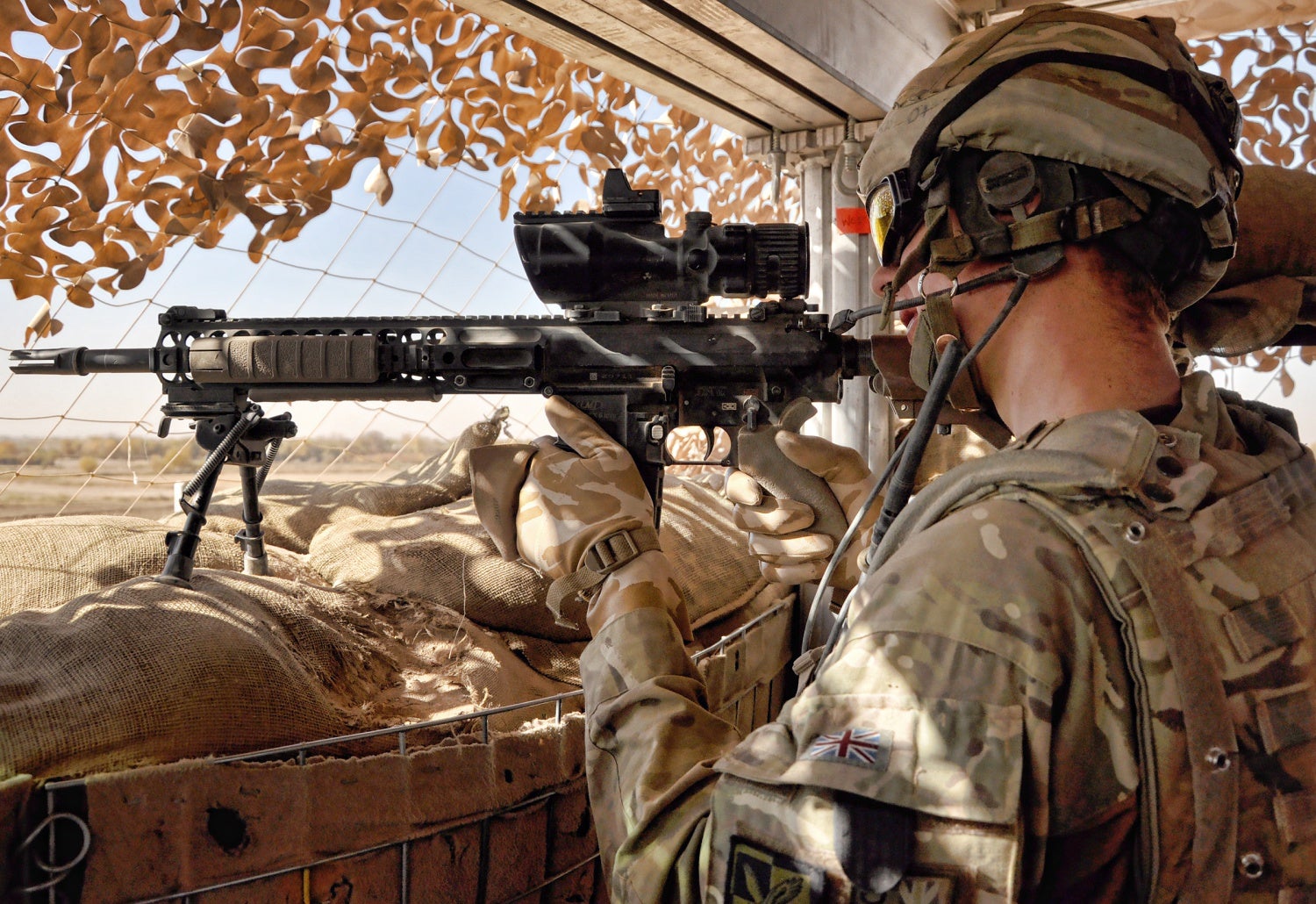
A member of the Royal Highland Fusiliers covers the construction of Route Trident in Afghanistan with his L129A1 Sharpshooter rifle in January, 2011. These very capable rifles and their optics cost the British government close to five figures per unit. Image source: commons.wikimedia.org
Therefore, a new rifle of this type would probably have a cost breakdown like so:
- Base rifle, grip, bipod, rails, light – $3,000 – $5,000
- Long Range Rifle Optic – $2,000 – $3,000
- PEQ-15 – $600
Total cost for our new long-range infantry rifles would therefore be somewhere in the ballpark of $5,000-$9,000 per unit, not including spares and support. This, however, is an estimate based on contracts with relatively low procurement numbers, so to adjust for economies of scale, we need to look to a larger contract. The French this year awarded Heckler and Koch a contract for over 100,000 of their HK416F rifles, at about $4,200 per unit, including spares and support. If we compare that to the USMC M27 contract, we get an imperfect but serviceable adjustment of 0.70 to account for the economy of scale, resulting in an estimated cost per unit for our rifles of $3,500-$6,300. We’ll just round that to $3,500-$6,000.
The current price of an M4 Carbine is far lower, with the most recent contracts for the rifles coming in at less than $650 per unit. Still the most common optic for these weapons is the M68 CCO, the military designation for the famous Aimpoint red dot sight, which the government purchases at around $600-$700, estimated. The Army also issues M150 Rifle Combat Optics, a variant of the famous Trijicon ACOG, initially purchased at $1,450/unit including accessories. Ancillaries on the M4 and M4A1 likely cost less than $500; even in 2003 the government paid less than $300 for the Knight’s rail system, and less than $60 for pistol grips and rail covers. Then, we can estimate the cost of a fully equipped M4 today as between $2,300 and $3,200.
The new long range rifle, then, represents a price hike of between 10% (lowest over highest) and 170% (highest over lowest), but probably between 50-100%, versus just procuring new M4 Carbines and all their kit. This extra expenditure might indeed be worth it, but only if troops were trained to use such a weapon to its fullest potential. That brings us to our next topic of discussion, training.
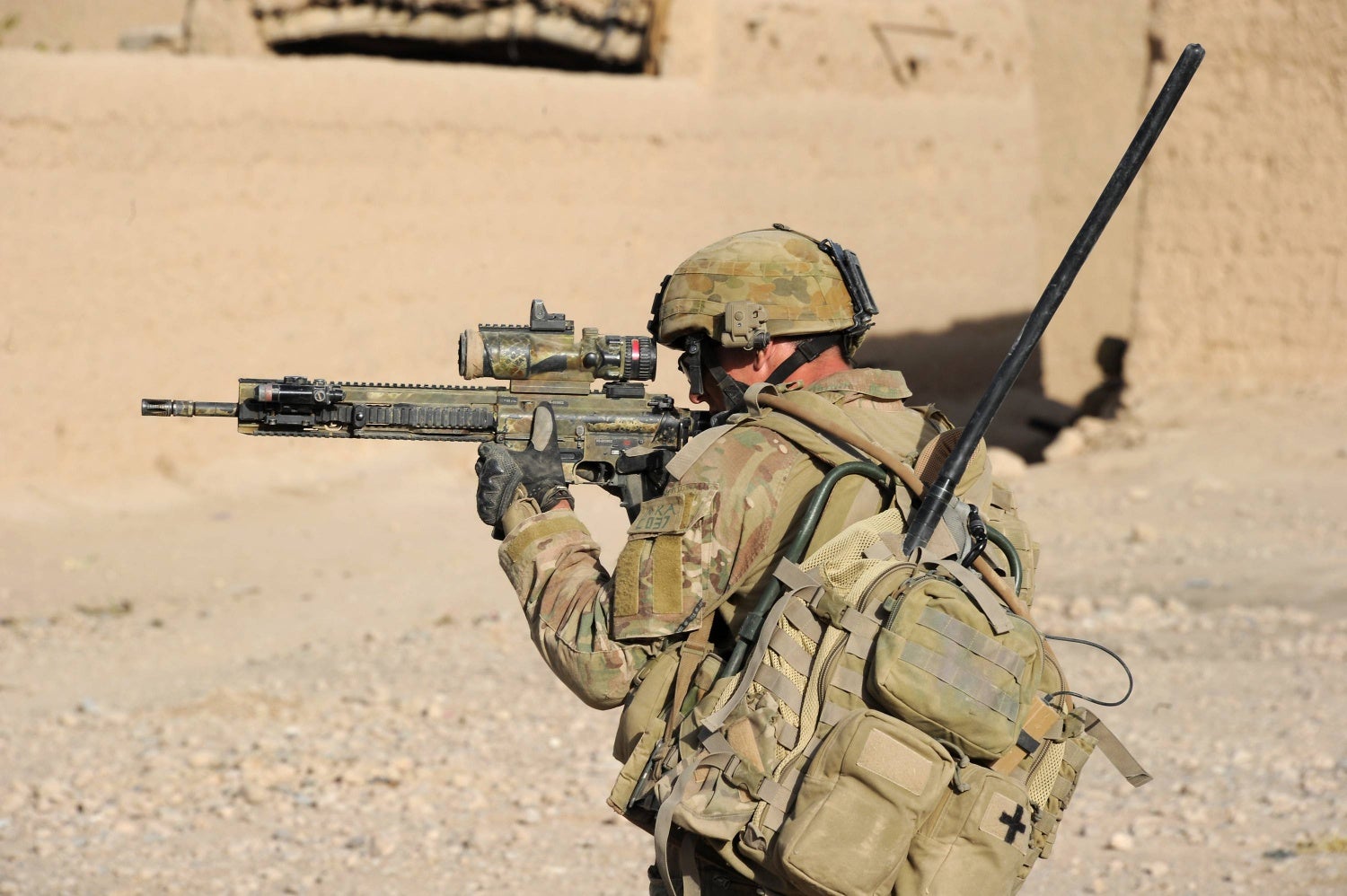
An Australian soldier aims his HK417 marksman’s rifle downrange. A very similar 7.62mm weapon to the British Army’s L129A1, it mounts the same Trijicon combination 6×48 ACOG/RMR sighting system. It is also a close sibling of Heckler & Koch’s HK416 and M27 rifles. Image source: imgur.com
It has often been argued that switching to a new, longer-ranged caliber would be trivially inexpensive in the big scheme of defense programs, and this is more or less true on the surface (although procurement of even a different off-the-shelf round would still probably cost well into the billions of dollars). However, one significant aspect that is often missed is that of training. A new caliber designed to give the infantry better long-range striking power does not well do its job if the infantry behind the trigger are not trained well enough to ensure that their rounds will hit the target – or at least miss close.
Unfortunately, the current marksmanship standards of the Army fall well short of the level that would be needed to enable the infantry to hit at 600 meters and beyond: In fact, a shooter capable of holding no tighter than 6.1 MOA while kneeling will always ace the Army rifle marksmanship qualifier with 40 out of 40 hits, where only 36 hits out of 40 are required to score at the highest level, expert, and only 23 out of 40 hits are required to qualify at all. This means that statistically speaking, a shooter who holds a spread of 11.1 MOA is very likely to pass the Army’s rifle qualification test as a “marksman”, a spread which at our threshold range of 600 meters is equivalent to six and a third feet, not exactly the precision we are hoping for. I should note that these marksmanship levels are more or less appropriate for the job currently given to the soldier; my purpose here isn’t to badmouth general Army marksmanship, but to illustrate how much improvement is necessary to achieve a comfortable degree of precision at the distances for which long range intermediate rounds are designed.
To achieve the greater degree of precision and hit probability needed to fully exploit a long range intermediate caliber, soldiers would need to be trained more extensively and more regularly in marksmanship and riflecraft. This training would require greater time, energy, and money to be devoted to training in the form of both dry and much more regular live fire practice. Further, qualifications may need to be held multiple times a year, and certainly would require tighter standards and firing conducted at bigger ranges – 25m simulated qualifications would not be enough to maintain a high enough degree of proficiency at long distance shooting. All this means more money spent on ammunition, salaries (more troops would be needed to rotate through tighter training and qualification schedules, and more instructors to teach them), and range maintenance.
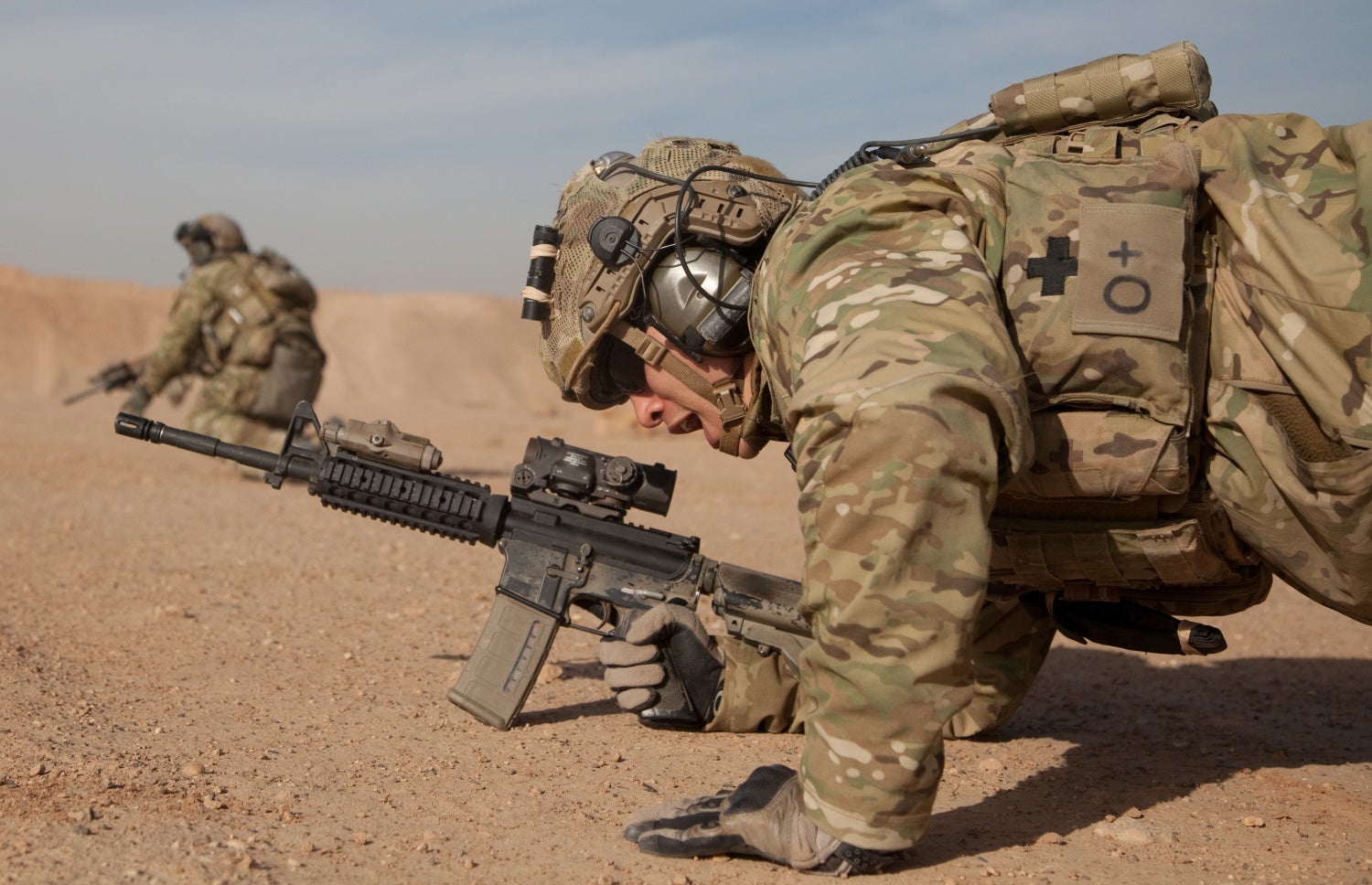
Sourced quote: “Coalition soldier participates in advance marksmanship training at a firing range on Forward Operating Base Bastion, Helmand province, Afghanistan, Jan. 18, 2013.” From: commons.wikimedia.org
As with marksmanship, an overhaul of the weapon maintenance practices would be essential to keeping the long range infantryman’s ability to overmatch his opponent. A $4,000 rifle system and quarterly marksmanship qualifications don’t mean very much if the rifle’s barrel is clapped out, or if it has gone out of headspace. Instead of simply maintaining a working rifle, the soldier would be tasked with keeping a precision instrument in top shooting condition. Rounds would need to be counted, and barrels and other components replaced at regular intervals. Rifles would possibly have to be evaluated for accuracy in a rest, and taken out of service for overhaul if they didn’t shoot to a certain standard. In short, the soldier, armorer, and others would need to work double time to keep the Army’s fleet of long range intermediate caliber rifles in the highest possible condition, ready to perform at distances up to a kilometer.
All of these changes would be good for the soldier’s effectiveness in any case, but they are also expensive, meaning more and more of the budget must be devoted to maintaining the individual infantryman’s edge over the enemy – an edge that could potentially be countered by one skilled enemy mortar crew on the other side of a hill. Still, even considering the costs and risks, it’s difficult to ignore the potential benefits of a well-trained army of capable and well-armed sharpshooters, who can pin and eliminate enemies even at long range. The question then becomes: Are the costs and risks worth it? And if they are deemed worth it, how does this new force of skilled marksmen change the nature of the infantry?
The first question is one for Fort Benning, but in this article’s third part we’ll take a whack at answering the second, when we tackle potential changes in organization and tactics.
 Your Privacy Choices
Your Privacy Choices
